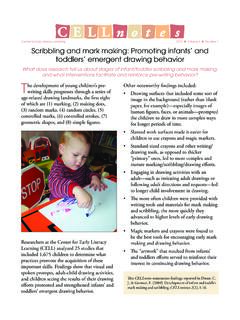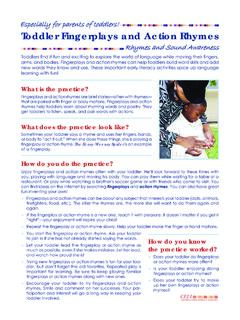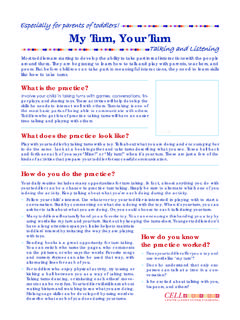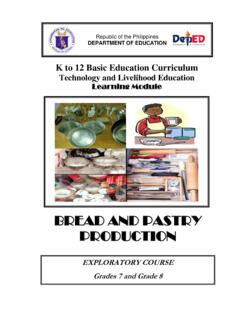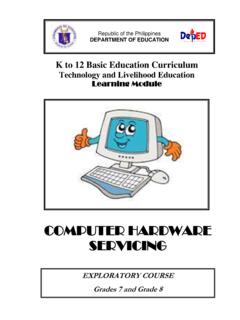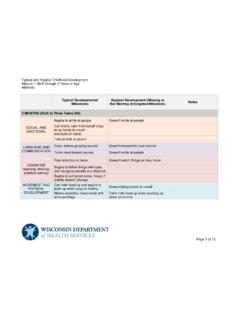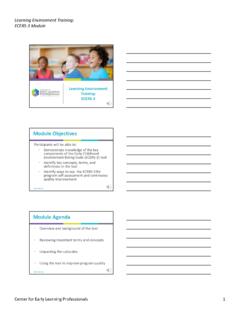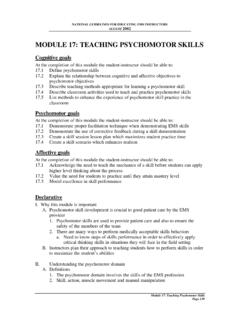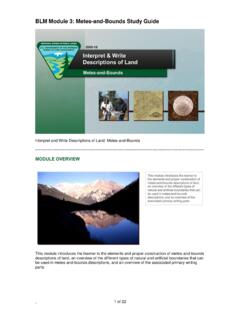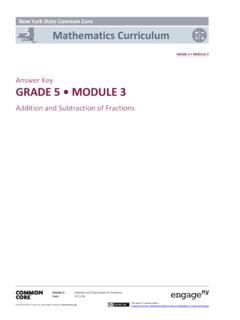Transcription of Literacy-Rich Environments - Early literacy Learning
1 Self-Guided Learning module Literacy-Rich Environments What is the CELL Self-Guided module ? This self-guided module focuses on Literacy-Rich Environments The purpose of this module is to share information about: The components of a Literacy-Rich environment Embedding materials across a Literacy-Rich environment Creating low-cost Literacy-Rich Environments 2. Pause and think about Literacy-Rich Environments before you proceed What does a Literacy-Rich environment look like? What kinds of materials would be in a literacy - rich environment? How could you use the same types of materials in different activities or Learning centers? Read the slides that follow to see CELL's responses to these questions. 3. Introduction: What does a Literacy-Rich environment look like? A Literacy-Rich environment is the context in which children engage in interest-based everyday literacy activities with responsive adults. Literacy-Rich Environments are: Interesting and offer a variety of literacy materials Inviting and comfortable Easily accessible for all children 4.
2 Introduction: What kinds of materials would be in a Literacy-Rich environment? Print-related materials calendars, menus, job charts, daily schedules, alphabet toys, labels, signs, etc. Reading materials books, magazines, photo albums, flyers, mail, recipes, coupons, etc. Writing materials pencils, markers, crayons, sponge shapes, letter stamps, paper, easels, etc. There also might be electronic materials such as books on tape, DVDs, electronic readers, computers, etc. 5. Introduction: How can you use the same types of materials in different activities or Learning centers? Materials can and should be used across different activities to help children develop their ability to use them in varying contexts. For example, dry-erase boards and markers could be used in the kitchen to create To Do . lists as well as in a reading area to practice writing/scribbling behavior. 6. Introduction: What Are Literacy-Rich Environments ? They are the contexts in which children engage in interest-based everyday literacy activities.
3 They stimulate children to participate in language and literacy activities. They are in classrooms, homes, and many other places around the community. They are interesting, inviting, comfortable, and well-stocked with easily accessible materials. 7. Introduction: What are the components of a Literacy-Rich environment? Classroom and home-based Literacy-Rich Environments generally include: Print, reading, and writing materials Learning centers in a classroom or areas in a home that provide opportunities for Early literacy Learning Adults who model the functional use or purpose of print, reading, and writing 8. Illustration: Classroom Environments Classroom settings often have a variety of Learning centers or areas that can provide opportunities for literacy Learning : Indoors greeting area, reading center, writing center, dramatic play center, computer center, art center, block center, music center, science center, snack/eating area, bathroom area Outdoors climbing structure, swings, sandbox, water table, field trips/walks, library visits 9.
4 Illustration: Home Environments Homes also contain a number of areas that can provide opportunities for Early literacy Learning : Indoors entry area, living room, dining room, kitchen, pantry, bedroom, home office, basement, bathroom, garage Outdoors yard, driveway/pavement, outdoor play areas, library visits, shopping, riding in the car/bus 10. Illustration: Materials Print materials store flyers, signs, labels, alphabet toys and posters, etc. Reading materials books, magazines, pamphlets, recipes, catalogs, etc. Writing materials Tools pencils, markers, crayons, chalk, paint brushes, etc. Surfaces paper, easels, chalkboards, etc. The CELL website offers a list of literacy examples for the home and classroom. Here is the link: 11. Illustration: Other Materials to Support literacy Learning Electronic materials CD players Headphones with books on CDs Computers with keyboards Electronic readers Props Flannel boards Magnetic boards and magnet letters Alphabet blocks Modeling clay 12.
5 Illustration: Embedding Materials in Functional Ways Focus on embedding materials throughout the environment in functional and natural ways. Functional use of materials means that children use the materials for a specific purpose. For example: Use paper and pencils to write a thank-you note. Cut out pictures of food items from store flyers to make a shopping list. 13. Illustration: Creating Low Cost Literacy-Rich Environments You can create a Literacy-Rich environment using many low-cost alternatives including: Re-use clean household-item packages with printed labels Collect discarded items and recyclables from local businesses Use free materials that come in the mail Collect free samples Request donations of materials Seek out free/low-cost books and other materials on the internet 14. Practice: Identify Literacy-Rich Environments Watch the video Making Room for literacy . Pay particular attention to the types of literacy materials and activities that are shown throughout the video.
6 When you have finished watching the video, make a list of the characteristics of a Literacy-Rich environment that you noticed in the activities depicted in the video. 15. Evaluation: Literacy-Rich Environments What literacy Learning activities did you see children doing? Where did literacy Learning activities occur? What materials were low-cost? How did the adults model the use of literacy in functional ways? 16. Practice: Setting Up a Literacy-Rich Environment Select a Learning center within your classroom that does not currently contain literacy materials or offer literacy Learning opportunities (therefore, not a book nook, library, or writing center). Design the Learning center or area so that it is part of a Literacy-Rich environment. When designing your Literacy-Rich center, be sure to note the following: Materials included Functional uses of materials Whether materials were high-, medium-, or low-cost 17. Evaluation: Literacy-Rich Environment In the activity just completed, what Learning centers or areas were adapted to include literacy materials?
7 What literacy materials were added to the Learning center? What low-cost materials were used and how did you acquire them? What literacy activities did the children do in these Learning centers/areas? How did the children respond to the changes? How did you support children's literacy experiences within the Learning centers? 18. Reflection: Literacy-Rich Environments Did you . Provide a variety of print, reading and writing materials that encourage Early literacy activities? Provide literacy materials that are interesting and inviting to children? Make sure that literacy materials are easily accessible to all children when appropriate? Demonstrate how literacy materials are used in everyday activities? 19. Thank you! Thank you for accessing the CELL. Self-Guided module on Literacy-Rich Environments Remember, you can download free resources from the CELL website at: 20.

